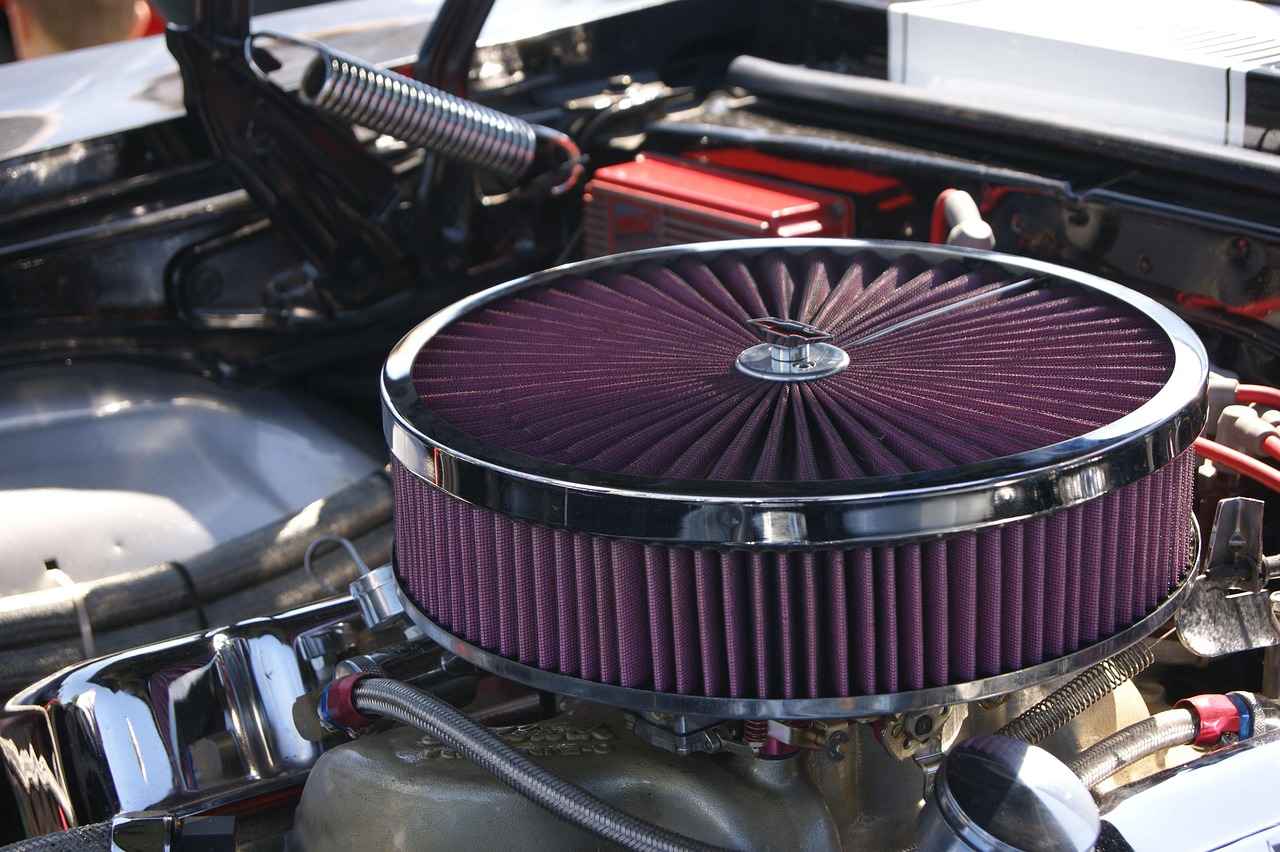This article provides a comprehensive step-by-step guide on replacing the cabin air filter in a Honda Accord, ensuring clean air circulation within your vehicle for a healthier driving experience. A clean cabin air filter is essential for maintaining air quality, which is crucial for both comfort and health while driving.
The cabin air filter plays a vital role in filtering out allergens, dust, and pollutants from the air that enters your vehicle. Over time, this filter can become clogged, leading to reduced airflow and poor air quality. By replacing your cabin air filter regularly, you can ensure that you and your passengers breathe clean air, which is particularly important for individuals with allergies or respiratory issues.
- Reduced airflow from the air conditioning or heating system.
- Unpleasant odors inside the vehicle, indicating mold or mildew buildup.
- Increased dust accumulation on the dashboard and interior surfaces.
Recognizing these signs early can prevent further issues with your vehicle’s HVAC system and improve your driving experience.
Before you begin the replacement process, gather the following tools:
- Screwdriver (flathead or Phillips, depending on your model).
- New cabin air filter (ensure compatibility with your Honda Accord).
- Vacuum cleaner (optional, for cleaning the filter compartment).
Having these tools ready will help streamline the process and minimize interruptions.
Selecting the correct cabin air filter model is crucial for compatibility and optimal performance. Check your vehicle’s manual or consult with your local auto parts store to ensure you purchase the right filter for your specific model year and trim level.
Follow these detailed steps to successfully replace the cabin air filter in your Honda Accord:
Start by turning off the engine and ensuring the vehicle is parked on a level surface. This will provide you with ample space to work comfortably while accessing the filter compartment.
The cabin air filter is typically located behind the glove compartment. To access it, you may need to remove the glove box by gently pressing in on the sides to release the stops.
Once you have located the filter, carefully pull out the old cabin air filter. Take note of its orientation, as the new filter must be installed in the same direction for optimal performance.
Insert the new cabin air filter into the compartment, ensuring it is positioned correctly. This is crucial for maintaining proper airflow and filtration efficiency.
It is generally recommended to replace your cabin air filter every 12,000 to 15,000 miles or at least once a year. However, if you frequently drive in dusty or polluted environments, you may need to replace it more often. Regular maintenance helps maintain air quality and HVAC efficiency in your Honda Accord.
- Not checking the orientation of the old filter before removal.
- Using an incompatible filter model.
- Neglecting to clean the filter compartment before installing the new filter.
Avoiding these mistakes will ensure a successful filter change and prolong the life of your vehicle’s HVAC system.
Regular maintenance of the cabin air filter not only improves air quality but also enhances the overall performance of your vehicle’s HVAC system. By ensuring that the filter is clean and functioning properly, you can enjoy a more comfortable driving experience, free from allergens and unpleasant odors.

Why Replace Your Cabin Air Filter?
When it comes to maintaining your vehicle, one of the most often overlooked components is the cabin air filter. This small yet vital part plays a significant role in ensuring that the air you breathe inside your car is clean and free from harmful particles. Understanding the importance of a cabin air filter is essential for maintaining air quality in your vehicle, preventing allergens and pollutants from entering the cabin.
The cabin air filter is designed to trap dust, pollen, and other airborne contaminants, providing a healthier driving experience. Over time, however, this filter can become clogged with debris, reducing its effectiveness. Here are several key reasons why you should consider replacing your cabin air filter regularly:
- Improved Air Quality: A clean cabin air filter helps to ensure that the air circulating in your vehicle is free from allergens and pollutants, making it especially important for individuals with allergies or respiratory issues.
- Enhanced HVAC Efficiency: A clogged filter can hinder the performance of your vehicle’s heating, ventilation, and air conditioning (HVAC) system. By replacing the filter, you can maintain optimal airflow and system efficiency.
- Odor Reduction: A dirty cabin air filter can lead to unpleasant odors inside the vehicle. Regular replacement can help eliminate musty smells and keep your car smelling fresh.
- Increased Safety: Clear visibility is crucial for safe driving. A clean cabin air filter ensures that the defrost and air conditioning systems function properly, preventing foggy windows that can obscure your view.
Many drivers may not realize that the cabin air filter requires regular maintenance just like other components of the vehicle. How often should you replace your cabin air filter? It is generally recommended to replace it every 12,000 to 15,000 miles or at least once a year, but this can vary based on driving conditions and environment. For instance, if you frequently drive in urban areas with high pollution levels or in regions with heavy pollen, you may need to replace the filter more often.
Recognizing the signs that indicate a clogged or dirty cabin air filter can save you from poor air quality and potential HVAC system issues. Look out for the following symptoms:
- Reduced Airflow: If you notice that the air coming from your vents is weaker than usual, it may be time to check the cabin air filter.
- Unpleasant Odors: A musty or stale smell when the air conditioning is running can indicate a dirty filter.
- Increased Allergies: If you or your passengers experience heightened allergy symptoms while driving, a clogged filter may be to blame.
In conclusion, understanding the importance of your cabin air filter is crucial for maintaining a comfortable and safe driving environment. By prioritizing its replacement, you not only enhance air quality but also improve the overall performance of your vehicle’s HVAC system. Regular maintenance of the cabin air filter can lead to a more enjoyable driving experience and contribute to your vehicle’s longevity.

Signs Your Cabin Air Filter Needs Replacement
When it comes to maintaining your vehicle, one of the most often overlooked components is the cabin air filter. This essential part plays a crucial role in ensuring that the air you breathe inside your car is clean and free from contaminants. However, over time, this filter can become clogged or dirty, leading to a range of issues that can affect both your health and the performance of your vehicle’s HVAC system. Recognizing the signs that indicate a need for replacement can save you from poor air quality and potential HVAC system issues.
- Reduced Airflow: One of the first signs that your cabin air filter is clogged is a noticeable decrease in airflow from the vents. If you find that the air is not blowing as strongly as it used to, it may be time to check the filter.
- Unpleasant Odors: A dirty filter can trap dust, mold, and other contaminants, leading to musty or unpleasant odors circulating in the cabin. If you notice a strange smell when you turn on the air conditioning or heater, your cabin air filter could be the culprit.
- Increased Allergies: If you or your passengers start experiencing more allergy symptoms, such as sneezing or itchy eyes, it could be due to a clogged filter that is failing to trap allergens and pollutants.
- Visible Dirt or Debris: If you can access the cabin air filter, take a look at it. If you see visible dirt, leaves, or other debris, it’s a clear indication that it needs to be replaced.
- Noisy HVAC System: A dirty filter can cause strain on the HVAC system, leading to unusual noises such as whistling or rattling. If you hear these sounds, it might be time to inspect the filter.
Ignoring the signs of a dirty cabin air filter can lead to a variety of problems. Not only can it result in poor air quality, but it can also put additional strain on your vehicle’s HVAC system, potentially leading to costly repairs. A clean cabin air filter ensures that your vehicle’s air conditioning and heating systems operate efficiently, which can save you money on fuel and repairs in the long run.
It’s recommended to check your cabin air filter every 12,000 to 15,000 miles, or at least once a year. However, if you frequently drive in dusty or polluted environments, you may need to inspect it more often. Regular maintenance not only enhances the air quality inside your vehicle but also contributes to the overall performance and longevity of your HVAC system.
If you recognize any of the signs mentioned above, it’s crucial to take action. Replacing the cabin air filter is a relatively simple and cost-effective process that can significantly improve your driving experience. Consult your vehicle’s owner manual for specific instructions on how to locate and replace the cabin air filter in your Honda Accord.
In summary, being vigilant about the condition of your cabin air filter is essential for maintaining a healthy and comfortable driving environment. By recognizing the signs of a dirty or clogged filter, you can ensure clean air circulation and avoid potential HVAC issues.

What Tools Do You Need?
Replacing the cabin air filter in your Honda Accord is a straightforward task that can significantly enhance the air quality within your vehicle. However, before embarking on this essential maintenance task, it is crucial to ensure that you are well-prepared. This preparation includes gathering the necessary tools to facilitate a smooth and efficient filter change, minimizing the risk of interruptions.
To successfully replace your cabin air filter, having the right tools on hand is essential. Below is a list of the tools you will need:
- Flathead Screwdriver: This tool is often required to remove any screws or clips that may be securing the filter cover in place.
- Torx Screwdriver: Depending on your Honda Accord model, you may need a Torx screwdriver for specific screws.
- New Cabin Air Filter: Ensure you have the correct replacement filter compatible with your vehicle model. Refer to your owner’s manual or consult with a local auto parts store for the right specifications.
- Gloves: Wearing gloves can help keep your hands clean and protect them from any sharp edges while working in the filter compartment.
- Vacuum Cleaner: A vacuum can help clean out any debris or dust that may have accumulated in the filter compartment before installing the new filter.
- Flashlight: A flashlight can be useful for illuminating dark areas, allowing you to see better while working on your vehicle.
Before you begin the replacement process, take a moment to gather all these tools in one location. This preparation will not only save you time but also prevent any unnecessary interruptions during the filter change. It’s frustrating to start a task only to realize you are missing a critical tool!
Additionally, it is advisable to have a clean workspace. Ensure that the area around your vehicle is free from clutter, allowing you ample room to maneuver. If possible, park your Honda Accord in a shaded area or garage to avoid direct sunlight, which can make the interior uncomfortably hot and may affect your ability to work efficiently.
Once you have gathered the necessary tools and prepared your workspace, you will be ready to proceed with the replacement process. This preparation sets the stage for a successful filter change, ensuring that you can focus on the task at hand without distractions.
In summary, taking the time to gather the appropriate tools and prepare your workspace is a vital step in the cabin air filter replacement process for your Honda Accord. This preparation not only enhances efficiency but also contributes to a more enjoyable and less stressful maintenance experience.

Finding the Right Cabin Air Filter for Your Honda Accord
When it comes to maintaining your Honda Accord, one of the essential components to consider is the cabin air filter. This filter plays a crucial role in ensuring that the air you breathe inside your vehicle is clean and free from pollutants. Finding the right cabin air filter for your Honda Accord is vital for compatibility and optimal performance, ensuring that your vehicle’s HVAC system operates efficiently.
Selecting the appropriate cabin air filter model is not just about fit; it directly affects the air quality within your car. A filter that is not compatible may lead to reduced airflow, increased allergens, and even damage to your vehicle’s HVAC system. Therefore, it is essential to prioritize quality and compatibility when making your selection.
- Particle Filters: These filters trap dust, pollen, and other particles, providing basic air quality improvement.
- Activated Carbon Filters: In addition to trapping particles, these filters also absorb odors and harmful gases, enhancing the overall driving experience.
- HEPA Filters: High-Efficiency Particulate Air filters offer the highest level of filtration, capturing even the smallest particles and allergens.
To guarantee that you choose the right cabin air filter, consider the following steps:
- Check Your Owner’s Manual: The manual contains specific information about the filter model recommended for your Honda Accord.
- Consult Online Resources: Many automotive websites provide detailed specifications and compatibility charts for various models.
- Visit an Auto Parts Store: Knowledgeable staff can assist you in finding the correct filter based on your vehicle’s make, model, and year.
While aftermarket filters may seem appealing due to their lower price, opting for OEM (Original Equipment Manufacturer) cabin air filters often ensures better performance. These filters are designed specifically for your Honda Accord, providing:
- Optimal Fit: OEM filters are engineered to fit perfectly, preventing any gaps that could allow unfiltered air to enter.
- Enhanced Filtration: They typically offer superior filtration capabilities compared to generic options.
- Longer Lifespan: OEM filters are often made from higher-quality materials, leading to increased durability and efficiency.
The frequency of replacing your cabin air filter can vary based on driving conditions and usage. However, a general guideline is to replace it every 15,000 to 30,000 miles or at least once a year. If you frequently drive in urban areas with heavy traffic or in regions with high pollen counts, you may need to replace it more often.
You can find cabin air filters at various locations, including:
- Auto Parts Stores: Local stores often carry a wide selection of filters.
- Online Retailers: Websites like Amazon and specialized auto parts retailers offer convenience and often better prices.
- Dealerships: For those who prefer OEM filters, your local Honda dealership is a reliable source.
In summary, selecting the right cabin air filter for your Honda Accord is essential for maintaining air quality and ensuring the efficiency of your vehicle’s HVAC system. By understanding the types of filters available, ensuring compatibility, and recognizing the importance of regular replacement, you can enhance your driving experience and keep your Honda Accord running smoothly.

Step-by-Step Guide to Replacing the Cabin Air Filter
This section provides an in-depth, step-by-step guide on how to replace the cabin air filter in your Honda Accord. Following these instructions will help ensure that you can easily and effectively change the filter, promoting better air quality within your vehicle.
Before you start the replacement process, it’s essential to prepare your vehicle. Begin by turning off the engine and ensuring the vehicle is parked on a level surface. This will provide you with a safe and comfortable workspace. Additionally, gather all necessary tools to minimize interruptions during the process.
The cabin air filter is typically located behind the glove compartment. To access it, open the glove compartment and remove any items inside. You may need to gently press in on the sides of the glove compartment to allow it to drop down further, exposing the filter cover. Refer to your owner’s manual for specific instructions related to your model year.
Once you have located the cabin air filter, carefully remove the old filter. Take note of how the filter is positioned, as you’ll need to install the new one in the same orientation. Be cautious during this step, as debris may fall into the filter compartment. If necessary, use a vacuum to clean any dust or debris present.
Now it’s time to install the new cabin air filter. Align the new filter according to the airflow direction indicated on the filter itself. Gently slide it into place, ensuring a snug fit. Once the filter is securely in position, replace the filter cover and reassemble the glove compartment.
It’s recommended to replace your cabin air filter every 15,000 to 30,000 miles, or at least once a year. However, if you frequently drive in dusty or polluted environments, you may need to replace it more often. Regular checks can help maintain optimal air quality and HVAC performance.
- Not Checking Compatibility: Ensure the new filter matches the specifications for your Honda Accord model.
- Ignoring the Orientation: Installing the filter incorrectly can impede airflow and reduce effectiveness.
- Neglecting to Clean the Area: Always clean the filter compartment before installing a new filter to avoid trapping dirt.
Regularly replacing your cabin air filter can lead to numerous benefits, including:
- Improved Air Quality: A clean filter helps trap allergens and pollutants, ensuring the air you breathe is fresh.
- Enhanced HVAC Efficiency: A clean filter allows your heating and cooling systems to operate more efficiently, saving energy.
- Extended Vehicle Lifespan: Maintaining clean air flow can contribute to the longevity of your vehicle’s HVAC system.
By following these detailed steps, you can confidently replace the cabin air filter in your Honda Accord, ensuring a healthier driving environment for you and your passengers.
Step 1: Prepare Your Vehicle
When it comes to replacing the cabin air filter in your Honda Accord, the first step is crucial for ensuring a smooth and efficient process. Preparing your vehicle is not just about turning off the engine; it involves creating a safe and comfortable working environment. Below are key considerations to keep in mind during this essential step.
Proper vehicle preparation sets the stage for a successful cabin air filter replacement. It minimizes the risk of accidents and ensures that you have everything you need within reach, allowing for a hassle-free experience.
- Turn Off the Engine: Always begin by switching off the engine to prevent any accidental starts while you’re working. This is a critical safety measure.
- Gather Your Tools: Before you begin, collect all necessary tools such as a screwdriver, a flashlight, and your new cabin air filter. Having everything on hand will save time and frustration.
- Park in a Safe Location: Ensure your vehicle is parked on a flat surface away from traffic. This reduces the risk of accidents and provides you with ample space to work.
- Open the Hood: If your model requires access from the engine compartment, open the hood and secure it with the prop rod to prevent it from falling.
- Clear the Area: Remove any obstacles around the area where you’ll be working. This includes personal items or tools that could hinder your movement.
- Check the Weather: If you’re working outside, ensure that the weather is suitable. Avoid working in rain or extreme temperatures to maintain your comfort and safety.
Having enough space to maneuver is vital. Make sure you have adequate lighting, especially if you’re working in a dimly lit garage or outside at dusk. A work light can be invaluable in illuminating the filter compartment. Additionally, consider using a mat or blanket to kneel on, which can prevent discomfort during the process.
Once you’ve prepared your vehicle, take a moment to double-check your setup. Ensure that your tools are easily accessible, and that you have your new cabin air filter ready to go. This will help streamline the replacement process and keep you focused.
By following these preparation steps, you will set yourself up for a successful cabin air filter replacement in your Honda Accord. Remember, a little preparation goes a long way in ensuring that the job is done efficiently and safely.
Step 2: Locate the Cabin Air Filter
Locating the cabin air filter in your Honda Accord is a crucial step in maintaining the air quality inside your vehicle. The position of the cabin air filter can differ significantly based on the model year and trim level of your Accord. Understanding where to find it can save you time and effort during the replacement process.
Knowing the exact location of the cabin air filter is essential for several reasons:
- Model Variations: Different model years and trims may have the filter situated in various locations, making it important to refer to your specific vehicle’s manual.
- Efficient Replacement: Identifying the correct spot allows for a quicker and more efficient replacement process, minimizing the time your vehicle is out of commission.
- Preventing Damage: Incorrectly accessing the filter can lead to damage to surrounding components, which can be costly to repair.
The cabin air filter is typically located in one of the following areas:
- Under the Dashboard: In many models, the filter is situated behind the glove compartment. You may need to remove the glove box to access it.
- Near the Engine Compartment: Some models have the filter located near the windshield, under the hood. This location may require you to remove a cover to gain access.
- In the Center Console: Certain trims may have the filter located in the center console area, which can be less common but is still possible.
To find the correct location of the cabin air filter for your specific Honda Accord:
- Consult the Owner’s Manual: The manual provides detailed diagrams and instructions tailored to your vehicle’s specifications.
- Online Resources: Numerous automotive forums and websites have dedicated sections for Honda vehicles, where you can find user-generated content and guides.
- Contact a Professional: If you’re unsure, seeking help from a certified mechanic can ensure that you locate the filter without causing any damage.
Using visual aids can greatly enhance your understanding of where to find the cabin air filter. Here are some tips:
- Diagrams: Look for diagrams in your owner’s manual or online that clearly show the filter’s location.
- YouTube Tutorials: Video tutorials can provide step-by-step guidance, showing you exactly how to access the filter in your model.
In conclusion, identifying the correct location of the cabin air filter in your Honda Accord is essential for proper maintenance and ensuring clean air circulation within your vehicle. By taking the time to locate it accurately, you can ensure a smoother replacement process and maintain a healthier driving environment.
Step 3: Remove the Old Cabin Air Filter
In the process of replacing the cabin air filter in your Honda Accord, is crucial. This step requires not only careful handling but also a keen eye for detail to prevent any damage to surrounding components. A successful removal sets the stage for a clean and effective replacement.
To begin, ensure that you have prepared your workspace adequately. Make sure the vehicle is parked on a flat surface with the engine off, and the keys removed from the ignition. This precaution is essential for your safety and to avoid any accidental mishaps while working on the vehicle.
Next, locate the cabin air filter compartment. Depending on the model year of your Honda Accord, this compartment is typically found behind the glove box or under the dashboard. Consult your vehicle’s manual if you are unsure of its exact location. Once you have located it, follow these steps:
- Open the Glove Box: Gently pull the glove box open. You may need to remove any items inside to have a clear view and access.
- Release the Stops: Look for the stops on either side of the glove box. These are small tabs that hold the glove box in place. Press these tabs inward to allow the glove box to drop down further.
- Access the Filter Cover: Once the glove box is fully lowered, you will see a cover panel that protects the cabin air filter. This cover may be secured with clips or screws, depending on your model.
- Remove the Cover: Carefully detach the cover by either unclipping or unscrewing it. Take your time to avoid breaking any clips, as they are often fragile.
With the cover removed, you can now see the old cabin air filter. Handle the old filter with care as it may be filled with dust, debris, and allergens. Gently pull the filter out of its housing, making sure not to disturb any surrounding components. If the filter is stuck, gently wiggle it back and forth to loosen it without applying too much force.
As you remove the old filter, take a moment to observe its condition. A clogged or dirty filter can significantly affect air quality and HVAC performance. If you notice excessive dirt or damage, it’s a clear indication that a replacement is necessary.
After successfully removing the old cabin air filter, it’s advisable to clean the surrounding area. Use a microfiber cloth to wipe down any dust or debris inside the filter compartment. This small step can help ensure that the new filter operates effectively, providing clean air circulation within your vehicle.
In summary, removing the old cabin air filter requires a careful and methodical approach. By paying attention to detail and following these steps, you can avoid damaging your vehicle’s components and prepare for a seamless installation of the new filter. This diligence not only enhances your driving experience but also contributes to a healthier environment inside your Honda Accord.
Step 4: Install the New Cabin Air Filter
When it comes to maintaining the air quality in your Honda Accord, installing the new cabin air filter correctly is not just a task; it is a necessity. This step is vital for ensuring optimal airflow and filtration efficiency, which directly affects the air quality inside your vehicle. A properly installed cabin air filter can significantly reduce the presence of allergens, dust, and other pollutants, contributing to a healthier driving experience.
Installing the cabin air filter incorrectly can lead to reduced airflow and ineffective filtration. This can cause the HVAC system to work harder, leading to potential damage and increased energy consumption. Furthermore, a misaligned filter may allow contaminants to bypass the filtration process, compromising the air quality you rely on while driving.
- Check the Orientation: Before inserting the new cabin air filter, ensure that it is oriented correctly. Most filters have an arrow indicating the direction of airflow. Align the filter according to this arrow to maintain optimal performance.
- Secure the Filter: After placing the filter in the compartment, make sure it fits snugly. A loose filter can vibrate and create noise while the vehicle is in motion, and may also allow unfiltered air to enter the cabin.
- Reattach Any Covers: If your Honda Accord has a cover or panel that secures the cabin air filter, make sure to reattach it properly. This will protect the filter from dirt and debris and ensure that it remains in place.
- Test the Airflow: Once everything is back in place, start your vehicle and turn on the air conditioning or heater. Check for any unusual noises or reduced airflow, which could indicate an installation issue.
Even the most experienced DIYers can encounter challenges during the installation process. Here are a few common issues and how to avoid them:
- Forgetting to Clean the Compartment: Before installing the new filter, take a moment to clean the filter compartment. Dust and debris can accumulate, which may affect the new filter’s performance.
- Using the Wrong Filter: Ensure you have the correct cabin air filter for your specific model year and trim of Honda Accord. Using an incompatible filter can lead to poor fit and function.
- Ignoring Maintenance Recommendations: Regularly replacing your cabin air filter is crucial. Refer to your vehicle’s owner manual for the recommended replacement schedule to maintain air quality.
By taking the time to install your new cabin air filter correctly, you are investing in the health and comfort of everyone in your vehicle. Clean air circulation not only enhances your driving experience but also prolongs the life of your HVAC system. Remember, regular maintenance and proper installation are key to achieving the best results. With these steps in mind, you can ensure that your Honda Accord continues to provide a fresh and comfortable environment for all passengers.

How Often Should You Replace Your Cabin Air Filter?
Maintaining a clean and efficient cabin air filter is essential for ensuring the best air quality inside your Honda Accord. Regular maintenance is key; understanding the recommended replacement frequency can help you maintain air quality and HVAC efficiency in your Honda Accord. In this section, we will explore how often you should replace your cabin air filter, the factors that influence this frequency, and the benefits of doing so.
Most manufacturers, including Honda, recommend replacing the cabin air filter every 15,000 to 30,000 miles or at least once a year. However, this can vary based on several factors:
- Driving Conditions: If you frequently drive in urban areas with heavy traffic, or in regions with high levels of dust and pollen, you may need to replace the filter more often.
- Climate: In areas with harsh weather conditions, such as extreme heat or cold, the cabin air filter may degrade faster.
- Usage: If you often use your vehicle for ridesharing or transporting pets, consider replacing the filter more frequently to maintain air quality.
Monitoring your vehicle’s performance can also help determine when to replace the filter. If you notice a decrease in airflow from the vents or a musty odor inside the cabin, it may be time to change the filter, regardless of mileage.
Failing to replace a clogged cabin air filter can lead to several issues:
- Poor Air Quality: A dirty filter can allow allergens, dust, and pollutants to enter the cabin, affecting your health and comfort.
- Reduced HVAC Efficiency: A clogged filter can restrict airflow, causing your heating and air conditioning systems to work harder, which can lead to increased fuel consumption.
- Potential Damage to the HVAC System: Over time, neglecting to replace the cabin air filter can cause strain on the HVAC system, potentially leading to costly repairs.
Being aware of the signs that indicate a need for a new cabin air filter can save you from discomfort and potential vehicle issues:
- Reduced Airflow: Noticeably less airflow from the vents is a common indicator that the filter is clogged.
- Unpleasant Odors: A musty or stale smell when the air conditioning or heating is on can signal a dirty filter.
- Increased Allergies: If you or your passengers experience increased allergy symptoms, it may be due to pollutants entering the cabin.
To ensure you stay on top of your cabin air filter maintenance:
- Set Reminders: Use your vehicle’s maintenance schedule or set reminders on your phone to check the filter regularly.
- Document Changes: Keep a log of when you replace the filter to help track its lifespan and performance.
- Consult Your Owner’s Manual: Refer to your Honda Accord’s owner’s manual for specific recommendations regarding cabin air filter maintenance.
In conclusion, understanding the importance of regular replacement of your cabin air filter is crucial for maintaining a healthy driving environment in your Honda Accord. By adhering to the recommended guidelines and being mindful of the signs that indicate a need for replacement, you can ensure optimal air quality and HVAC efficiency in your vehicle.

Common Mistakes to Avoid When Replacing the Cabin Air Filter
When it comes to maintaining your Honda Accord, one of the essential tasks is replacing the cabin air filter. However, many car owners inadvertently encounter issues during this process. Being aware of common pitfalls during the replacement process can prevent damage and ensure a successful filter change. Below are some critical mistakes to avoid, along with tips to help you navigate through the replacement smoothly.
One of the first mistakes is not consulting the owner’s manual before starting the replacement. The manual provides specific instructions on how to access the cabin air filter, including its exact location, which can vary by model year. Ignoring this guidance may lead to unnecessary confusion and potential damage to your vehicle.
Another common error is failing to select the correct filter type. Cabin air filters come in various sizes and specifications. Using an incompatible filter can lead to poor air circulation and might even damage your vehicle’s HVAC system. Always verify the filter model compatible with your Honda Accord.
Many individuals rush through the replacement, which can result in overlooking critical steps. Take your time to carefully remove the old filter and inspect the area for any debris or damage. Rushing can lead to improper installation and future issues with air quality.
After removing the old filter, it’s vital to clean the filter compartment before installing the new one. Dust and debris can accumulate in this area, which may affect the performance of the new filter. A quick clean-up will ensure optimal airflow and filtration efficiency.
Before installing the new cabin air filter, check for any obstructions or damage in the filter housing. Sometimes, leaves or other debris can get lodged in the compartment, which can hinder the performance of the new filter. Addressing these issues beforehand is crucial for maintaining air quality.
Improper installation of the new filter is a frequent mistake. Make sure to align the filter correctly according to the airflow direction indicated on the filter itself. Installing it incorrectly can lead to reduced air quality and potential HVAC issues.
After replacing the cabin air filter, some drivers forget to reset the maintenance light (if applicable). This can lead to confusion about when the next maintenance is due. Always check your vehicle’s settings to ensure everything is updated.
Finally, neglecting to adhere to the recommended replacement frequency can lead to problems down the line. Regularly replacing the cabin air filter is essential for maintaining air quality and ensuring your HVAC system operates efficiently. Refer to your owner’s manual for guidance on how often to change the filter.
By avoiding these common mistakes, you can ensure a smooth and effective cabin air filter replacement process. This not only enhances the air quality inside your Honda Accord but also contributes to the overall longevity of your vehicle’s HVAC system.

Benefits of Regular Cabin Air Filter Maintenance
Maintaining your vehicle’s cabin air filter is not just a routine task; it is a crucial aspect of vehicle upkeep that can significantly affect your driving experience. The cabin air filter plays a vital role in ensuring that the air you breathe inside your car is clean and free from harmful contaminants. Regular maintenance of the cabin air filter can yield several benefits that enhance both air quality and the overall performance of your vehicle’s HVAC system.
The cabin air filter is responsible for filtering out dust, pollen, and other airborne particles that can enter your vehicle’s interior. By keeping this filter clean, you can:
- Improve Air Quality: A clean cabin air filter prevents allergens and pollutants from circulating in the cabin, leading to a healthier environment for you and your passengers.
- Enhance HVAC Performance: Regular maintenance ensures that your heating, ventilation, and air conditioning (HVAC) system operates efficiently, providing consistent airflow and temperature control.
- Increase Fuel Efficiency: A clogged filter can strain your HVAC system, leading to increased fuel consumption. Regular replacement can help maintain optimal performance and fuel efficiency.
Breathing clean air is essential for your health, especially during long drives. A well-maintained cabin air filter can:
- Reduce Allergens: For those prone to allergies, a clean filter can significantly decrease symptoms by trapping pollen, dust, and other irritants.
- Minimize Odors: A dirty filter can harbor mold and bacteria, leading to unpleasant smells. Regular maintenance helps keep your vehicle smelling fresh.
Neglecting the maintenance of your cabin air filter can lead to several issues:
- Decreased Air Quality: A dirty filter allows contaminants to enter the cabin, potentially causing respiratory issues.
- HVAC System Strain: A clogged filter forces the HVAC system to work harder, which can lead to premature wear and costly repairs.
- Increased Energy Consumption: An inefficient HVAC system consumes more energy, leading to higher fuel costs.
It is generally recommended to replace your cabin air filter every 12,000 to 15,000 miles or at least once a year, but this can vary based on driving conditions and personal preference. If you frequently drive in dusty or polluted environments, you may want to check and replace the filter more often.
In summary, regular maintenance of your cabin air filter is essential for ensuring clean air quality and optimal performance of your vehicle’s HVAC system. By prioritizing this simple yet effective maintenance task, you can enjoy a healthier and more comfortable driving experience.
Frequently Asked Questions
- How do I know when to replace my cabin air filter?
If you notice reduced airflow from your vents, a musty smell inside the cabin, or if it’s been over 15,000 miles since the last change, it’s time to consider replacing your cabin air filter.
- Can I replace the cabin air filter myself?
Absolutely! Replacing the cabin air filter is a straightforward process that you can do at home with minimal tools. Just follow the step-by-step guide and you’ll be set!
- What happens if I don’t replace my cabin air filter?
Neglecting to replace your cabin air filter can lead to poor air quality, increased allergens, and can even strain your HVAC system, leading to costly repairs down the line.
- Where can I buy a cabin air filter for my Honda Accord?
You can find cabin air filters at auto parts stores, online retailers, or directly from your Honda dealership. Just make sure to choose the correct model for your specific year and trim!
- Is it worth investing in a high-efficiency cabin air filter?
Yes! High-efficiency filters can trap more pollutants and allergens, providing cleaner air and a healthier driving experience, especially for those with allergies or respiratory issues.



